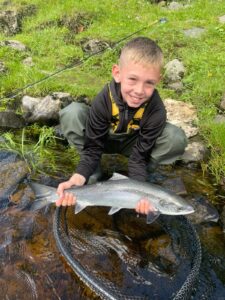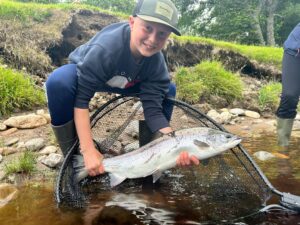The Spey Fishery Board is now able to declare that catches of Salmon and Grilse for the 2020 season have amounted to 5,622, in comparison to the 5,090 caught last year. That equates to an increase of over 10% compared with the previous year. Considering that there was almost no fishing for two months, and in many cases, three months of a seven-and-a-half-month season, that is a very positive result for the River. The total also included a more significant run of Grilse (which are Salmon that have spent only one winter at sea before returning to the River) than had been expected, with just over 2,200 Grilse being caught in 2020. This also bodes well for multi-sea-winter salmon returning to the River next year.
The Spey Board is also able to report that 987 Sea Trout were caught during the season, which is lower than would have been expected. That said, the most prolific months for Sea Trout catches on the Spey have historically been June, followed by July. This year, the COVID lock-down restrictions were eased on the 5th June, but only for local anglers, and the hospitality sector was only permitted to re-open from the 15th July. So, there were no visiting anglers for three-quarters of the most prolific time for sea trout to be caught in the Spey catchment and we suspect that this is a significant reason for the reduction.
Anglers have also continued to respond positively to the voluntary Conservation Policies that are in place on the River Spey, by returning even more fish caught than ever before. Throughout the season, 98% of all Salmon and Grilse caught were released, as they were last year, together with the 91% of sea trout. Last year, 86% of sea trout were released to spawn. The Board is grateful to all of the proprietors and especially the ghillies, whom it recognises have played such an active role in persuading so many anglers to continue to support the policy.






2 thoughts on “2020 Catches”
With all the conservation measures that the anglers and others that are doing to the habitat of our rivers including the spey.
Can you see any improvements in returning fish over a period not just one year ?
I hear quite often especially from the spey fisheries board, on Facebook how healthy the river and tributaries are bursting with high density levels of fish.
Yet the numbers of returning fish seem to be still slowly spirraling downwards.
Do you have any information of why the fish are not returning and is the spey at full capacity for producing smolts, and would a stocking policy help the recovery?
Many thanks in anticipation of your reply
Andrew presley
Hi Andrew, the lower number of returning adults is of concern to all, it is the basis of the fishery economy of course. We are involved with initiatives such as the Missing Salmon Project, and other smolt tracking projects which have the aim of trying to establish where losses, of smolts for example, are occurring. This work is in its early stages and it is not possible to draw conclusions. The initial results highlight poor survival in river but the causes are not yet established.
I should also add that we have a stocking policy. The Spey has had a hatchery in full-time operation since the late 60s. The hatchery production varied over the years, as recently as the early 2000s hatchery production was over 2million. This seemed to have little impact, indeed genetic studies showed it to influence catches by between zero and 1.8% over a five year period.
We seem to be in a transition period as the runs switch from late to early running, historically a period when catches were in the doldrums. The first tangible signs of a recovery in the spring runs may be appearing, more so in other rivers. The strong juvenile classes of 2017 and 2018 are not starting to appear in the runs (grilse 2020) and will form the entire runs in the next couple years. Hopefully this will translate into improved adult returns e.g. two sea-winter in 2021.